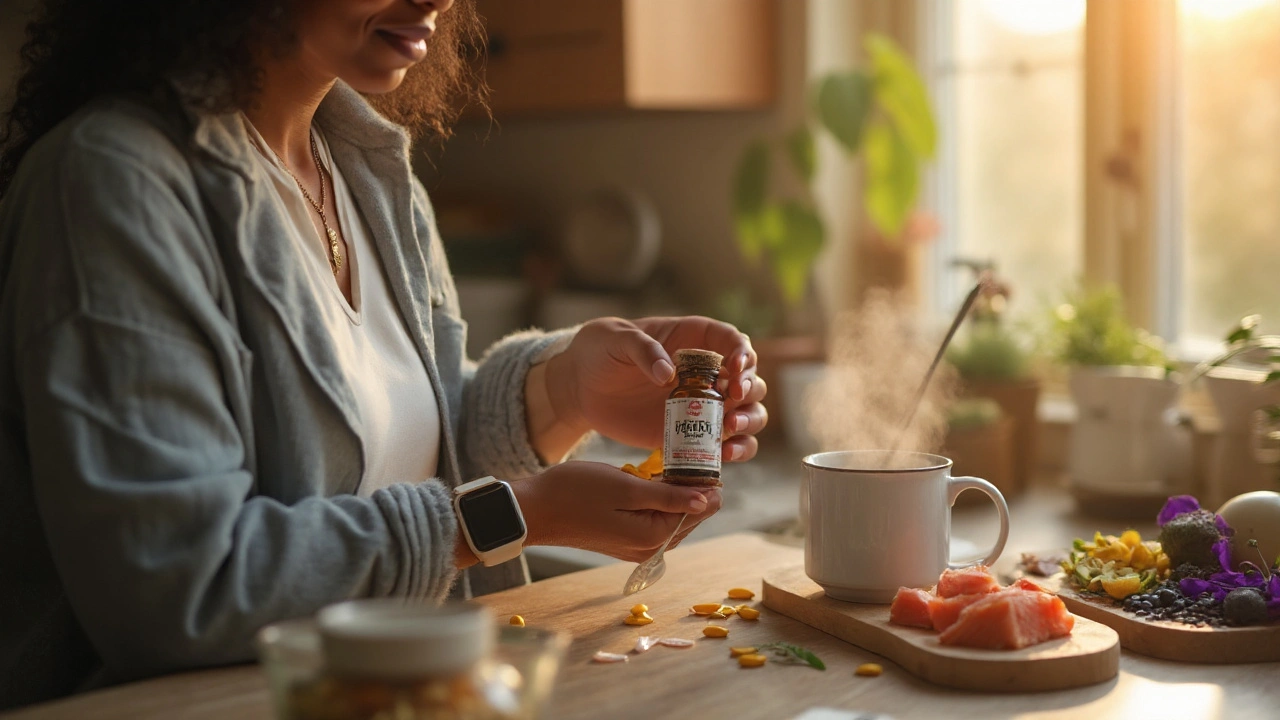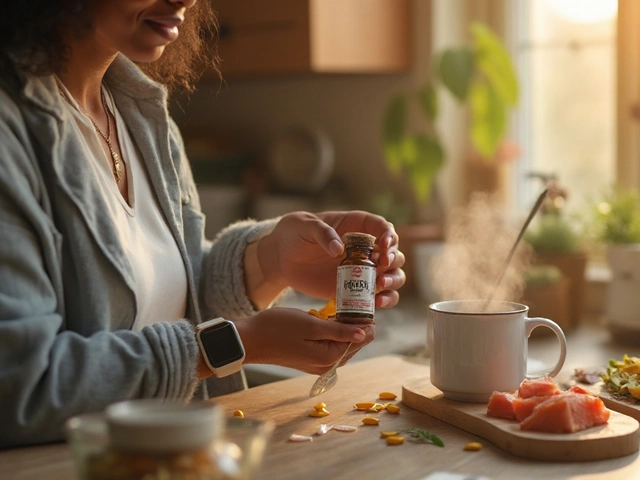- Heart's Ease is a natural heart-support supplement. Expect modest, trackable benefits over 8-12 weeks, not a miracle fix.
- Judge it by evidence-backed ingredients and real doses: CoQ10, omega-3 EPA/DHA, magnesium, aged garlic, and hawthorn have the best data.
- Safety matters: watch interactions (warfarin, statins, ACE inhibitors, anticoagulants). Check for third‑party testing.
- Best fit: adults wanting extra support alongside diet, exercise, and prescribed care. Not for pregnancy, surgery windows, or unmonitored arrhythmias.
- Budget NZ$40-NZ$120/month. Track BP, lipids, HR variability, energy, and exercise tolerance to see if it's working.
Cardiovascular disease still takes roughly one in three lives in New Zealand, and a lot of us want an edge that doesn’t come in a prescription bottle. A heart supplement sounds simple: swallow a capsule, live longer. The real story is more grounded. Some ingredients can support heart function, blood pressure, and lipids-especially as part of a bigger plan-but products vary wildly, and dosing is where the truth shows up. Here’s a clear, no-nonsense look at Heart's Ease: what to look for on the label, what evidence says, how to use it safely, and when to skip it.
What Heart's Ease Claims-and How to Judge It Before You Buy
Most heart supplements promise support for circulation, blood pressure, energy, and healthy aging. The right question isn’t “Does it work?” but “Which parts work, at what dose, and for whom?” Use these decision rules before you spend a cent.
- Evidence first: Prioritize ingredients with human clinical data-CoQ10 (heart failure symptom support and statin-associated muscle symptoms), omega‑3 EPA/DHA (triglycerides and specific event reduction in high‑risk groups), magnesium (blood pressure in deficient folks), aged garlic extract (modest BP and plaque progression signals), and hawthorn (symptom support in mild heart failure). Key sources: Circulation and JAMA (omega‑3 trials like REDUCE‑IT 2018), Cochrane Reviews (hawthorn 2012), Heart Failure Reviews (CoQ10 meta‑analyses, 2018), Hypertension (magnesium, 2020).
- Clinically realistic doses: Labels should match study ranges. CoQ10: 100-300 mg/day; Omega‑3 EPA+DHA: 1-2 g/day for general support (higher under medical care); Aged garlic: 1-1.2 g/day; Hawthorn extract (standardized): 160-900 mg/day; Magnesium (elemental): 200-400 mg/day (glycinate or citrate is gentler on the gut).
- Standardization matters: Plant extracts should list active marker compounds (e.g., hawthorn oligomeric procyanidins). Garlic should specify “aged extract” and S‑allyl cysteine content.
- Safety guardrails: If you see red yeast rice (monacolin K), treat it like a statin-interactions and liver considerations apply. Medsafe has cautioned that such products can act like prescription meds. If you’re on warfarin, avoid vitamin K-heavy blends unless your clinician adjusts your dose.
- Testing and transparency: Look for batch numbers, a COA (certificate of analysis), and third‑party testing (e.g., USP, NSF, Informed Choice). This cuts the risk of contamination and dose drift.
- Realistic claims: Nobody can legally promise to “cure” heart disease. Be wary of miracle words, detox language, and long ingredient lists with pixie dust doses.
If the Heart's Ease label you’re holding ticks these boxes-evidence‑backed compounds, proper doses, clean testing-you’re looking at a serious product. If not, it’s marketing with herbs.
Ingredients That Actually Help Your Heart
Here’s the short list of ingredients with credible human data, what they do, and how to use them. If Heart's Ease leans on these at good doses, your odds of seeing benefit go up.
- Coenzyme Q10 (CoQ10): Your heart burns through ATP, and CoQ10 helps make it. As we age or take statins, CoQ10 levels dip. Meta‑analyses in Heart Failure Reviews (2018) found symptom improvements and fewer hospitalizations when added to standard therapy. Dose: 100-300 mg/day with a meal containing fat. Ubiquinol is better absorbed than ubiquinone for some people.
- Omega‑3 (EPA/DHA): Consistent evidence shows triglyceride lowering and, in high‑risk folks on statins, high‑dose EPA reduced events (REDUCE‑IT, 2018; New England Journal of Medicine). For general support, 1-2 g EPA+DHA/day is a fair target; for triglycerides, 2-4 g/day under clinician guidance. Pick IFOS‑certified or similar to avoid oxidation.
- Magnesium (as glycinate or citrate): Low magnesium links to higher arrhythmia and blood pressure. A 2020 meta‑analysis in Hypertension showed small but meaningful BP reductions, especially in those with low baseline levels. Start at 200 mg elemental/day, move up if tolerated. Avoid oxide (poor absorption, more GI upset).
- Aged Garlic Extract (AGE): Trials out of UCLA have reported modest BP support and slower plaque progression over a year in some cohorts. Typical dose: 1-1.2 g/day standardized AGE.
- Hawthorn (Crataegus): Cochrane (2012) noted improved exercise tolerance and symptoms in mild heart failure when used alongside meds. It’s not a replacement for therapy. Standardized extract 160-900 mg/day, split doses.
- Taurine: Emerging data (including 2023 mechanistic studies) suggest benefits for blood pressure and endothelial function. Common dose is 1-3 g/day; good safety profile.
- Vitamin D3 and K2: Observational data link vitamin D status with heart risk; RCTs for hard outcomes are mixed. K2 (MK‑7) has early signals for arterial stiffness but not hard endpoint wins. Keep doses conservative and avoid K2 if you use warfarin unless your INR is managed.
Ingredients to treat carefully:
- Red Yeast Rice: Contains monacolin K (lovastatin). Effective for LDL, but it’s basically a statin with inconsistent dosing across products and potential liver/muscle issues. In NZ, treat it as medicine‑like and talk to your GP.
- Niacin (high dose): Lowers LDL and raises HDL, but outcome trials didn’t show added benefit on top of statins and increased side effects. Keep it low unless supervised.
What does a strong heart‑support blend look like? As an example formula to benchmark labels (not the actual Heart's Ease label):
- CoQ10 200 mg (ubiquinol) with fat
- Omega‑3 delivering 1 g EPA + DHA/day (from TG‑form fish oil)
- Magnesium glycinate 200-300 mg elemental/day
- Aged Garlic Extract 1.2 g/day
- Optional: Hawthorn standardized 300 mg/day, Taurine 1-2 g/day
That kind of build aligns with the evidence and avoids weak “kitchen sink” dosing.

Safety, Interactions, and Who Should Skip It
Natural doesn’t mean trivial. Your heart meds and supplements can clash. Here’s the short, practical safety map.
- Anticoagulants and antiplatelets (warfarin, apixaban, clopidogrel): Fish oil at usual doses has low bleeding risk, but stacking multiple “blood‑friendly” herbs (garlic, hawthorn, ginkgo) can add up. If your INR is managed, don’t change vitamin K intake abruptly and avoid K2 unless your clinician approves.
- ACE inhibitors/ARBs and potassium‑sparing diuretics: Be careful with magnesium/potassium blends because of hyperkalemia risk. Stick to magnesium alone if needed and check labs if you have kidney issues.
- Statins: CoQ10 can help with statin‑associated muscle symptoms for some people. Red yeast rice plus a statin is a no. Monitor liver enzymes if you’re on anything lipid‑active.
- Blood pressure meds: Hawthorn and aged garlic can add to BP‑lowering. That’s great if measured, risky if you’re guessing. Track at home and adjust with your GP.
- Arrhythmias: If you have AFib, SVT, or PVCs, run new supplements past your cardiologist. Electrolytes like magnesium can help in specific cases but can also mask bigger issues.
- Pregnancy/breastfeeding: Skip complex blends. Safety data are thin.
- Surgery: Stop botanicals like garlic/hawthorn 7-10 days before procedures because of bleeding risk.
How to sanity‑check a product in 60 seconds:
- Scan for doses that match study ranges (not just ingredient name drops).
- Check for third‑party testing and a COA or batch number.
- Make sure there’s no red yeast rice unless you intend to use a statin‑like product.
- Review interactions with your meds (especially blood thinners and BP meds).
- Buy a 60-90 day supply so you can judge effect properly. >
How It Stacks Up: Alternatives, Trade‑offs, and Best Fit
Some people do better with single‑ingredient precision. Others like an all‑in‑one. Here’s a quick comparison to help you choose.
| Option | Best For | Not Great For | Evidence Strength | Notes |
|---|---|---|---|---|
| CoQ10 (solo) | Adults on statins; low energy; mild HF symptom support | LDL lowering | Moderate for symptoms | Take with fat; 100-300 mg/day |
| Omega‑3 EPA/DHA | High triglycerides; general heart support | Fast LDL lowering | Strong for TGs; mixed for events unless high‑risk & high‑dose EPA | 1-2 g/day for support; watch quality |
| Aged Garlic Extract | Modest BP and plaque progression signals | Rapid BP normalization | Moderate | 1-1.2 g/day; possible odor‑free |
| Magnesium (glycinate) | Mild hypertension; cramps; sleep support | Severe hypertension | Moderate for BP | 200-400 mg/day; adjust for GI |
| Hawthorn extract | Adjunct symptom support in mild HF | Replacing HF meds | Moderate for symptoms | 160-900 mg/day; split doses |
| Red Yeast Rice | LDL lowering when statins not tolerated | Combining with statins | Strong for LDL; med‑like risks | Monitor liver and muscles |
| All‑in‑one blend (e.g., Heart's Ease) | Convenience; broad support | Precise dose control | Depends on doses/testing | Judge by label, not the marketing |
Who is a blend like Heart's Ease “best for”?
- People already working on diet (Mediterranean‑style), movement, sleep, and stress-and want an extra 5-15% boost.
- Those on statins who want CoQ10 and BP support in one place.
- Busy adults who won’t manage a five‑bottle stack.
Who should pass?
- Anyone wanting to replace prescribed therapy for hypertension, diabetes, arrhythmias, or heart failure.
- People with complex meds (warfarin, multiple cardiac drugs) unless coordinated with a clinician.
- If the label shows low doses or vague standardization-buy the proven singles instead.
NZ‑specific practicalities (2025):
- Price: Expect NZ$40-NZ$120 per month depending on dosing and third‑party testing.
- Availability: Major NZ retailers often carry CoQ10, omega‑3, magnesium, and garlic. Blends vary by stockist-check batch testing notes.
- Regulation: Supplements here are food‑grade, not medicine. Medsafe issues advisories for risks like red yeast rice. Hard claims should raise an eyebrow.
How to Use It Right: Doses, Timelines, Tracking, and Next Steps
If you choose Heart's Ease supplement, treat it like a 90‑day project you can measure. That’s how you tell signal from noise.
Step‑by‑step plan:
- Baseline this week: Home blood pressure (morning/evening x 3 days), resting heart rate, body weight, and a fasted lipid panel if you can. Note your average energy and exercise tolerance (e.g., how a 30‑minute brisk walk feels).
- Start low: If the label has multiple actives, begin at half dose for a week to check tolerance. Then move to full dose with your main meal.
- Be consistent: Take it daily with food. Fish oil oxidizes-keep it cool and check for a fishy burp (a sign to switch brands).
- Track weekly: BP, resting HR, step count, and a short note on energy and sleep. If you use a smartwatch, check HR variability (HRV) trends-rising HRV can hint at better recovery.
- Re‑check at 8-12 weeks: Repeat BP and lipids. Look for: 2-5 mmHg BP drop, triglycerides lower, fewer leg cramps, steadier energy, better exercise recovery.
- Decide: If you see zero change and your lifestyle is dialed, the formula or dose isn’t right for you. Swap to single‑ingredient precision based on your data. >
Cheat sheet: good daily dose ranges to see an effect
- CoQ10: 200 mg (start at 100 mg if small/light)
- Omega‑3: 1-2 g EPA+DHA (split doses if burps)
- Magnesium glycinate: 200-300 mg elemental (evening is nice)
- Aged Garlic Extract: 1-1.2 g
- Hawthorn extract: 300 mg (standardized)
Pitfalls to avoid:
- Stacking too much too fast: Add one new thing every 1-2 weeks so you know what did what.
- Ignoring meds: Don’t reduce BP or statin doses on your own. Bring your readings to your GP and decide together.
- Chasing numbers alone: Energy, sleep, and exercise tolerance matter too. Longevity is more than LDL.
Troubleshooting:
- Fishy burps: Switch to enteric‑coated, take with dinner, or try algal EPA/DHA.
- GI upset from magnesium: Change to glycinate, drop dose by 100 mg, or split AM/PM.
- Lightheadedness: Could be BP lowering. Check readings; if systolic is under your target or you feel faint, pause and talk to your clinician.
- No change at 12 weeks: Verify doses against study ranges. If under‑dosed, either adjust or move to targeted singles with proven amounts.
Ethical buying tips:
- Check for third‑party testing and oxidation metrics for fish oil (anisidine/peroxide-brands often publish these).
- Make sure botanicals are standardized and list marker compounds.
- Use batch‑specific COAs when possible.
Mini‑FAQ
- Can a supplement lengthen my life? The strongest longevity drivers are still exercise, blood pressure control, not smoking, sleep, and a Mediterranean‑style diet. Supplements can support those systems, and some (omega‑3 in high‑risk patients, CoQ10 in heart failure) show outcome benefits in certain settings. Think “assist,” not “anchor.”
- How long until I notice anything? Energy changes from CoQ10 can show in 2-4 weeks. BP shifts from garlic/magnesium may take 4-8 weeks. Lipids usually need 8-12 weeks.
- Is plant‑based omega‑3 oil OK? Algal oil is great for EPA/DHA without fish. Flax (ALA) isn’t enough on its own for triglycerides.
- Can I mix it with coffee? Yes. Take fat‑soluble ingredients (CoQ10) with a meal for better absorption.
- What if I’m already on three cardiac meds? Bring the label to your GP or pharmacist. In NZ, pharmacists are excellent at spotting interactions and timing doses.
If you remember just one thing: use data, not hope. Pick evidence‑backed ingredients at real doses, track for 90 days, and keep your doctor in the loop. That’s how a “natural” approach actually moves the needle on a very real problem.




Kevin Huckaby
August 30, 2025 AT 01:33I've seen a lot of hype around natural heart pills, and it usually falls flat 😒
Brandon McInnis
September 4, 2025 AT 13:33Back when I was training for my first marathon, I tried a few heart‑support blends just to see if they’d make a difference. I logged my runs, my heart rate, and my blood pressure every morning. The labels promised better circulation and more energy, but I stuck to the plan of diet and sleep first. Over eight weeks I noticed a slight uptick in stamina, but it was hard to tease out whether the supplement or the progressive training was the cause. The key takeaway? No single pill can replace consistent lifestyle habits, but a well‑formulated blend can act as a tiny safety net. So, if you’re curious, look for real doses, third‑party testing, and track your own numbers before buying into hype.
Aaron Miller
September 10, 2025 AT 01:33Indeed!!! The interplay of CoQ10, omega‑3, and magnesium forms a synergistic cascade-provided the formulation respects pharmacokinetic thresholds; otherwise you’re merely polishing a brick. One must scrutinize not only the milligram count but also the bioavailability matrix-liposomal delivery versus triglyceride‑bound oil, for instance. Moreover, the regulatory landscape in the States permits waffling on “natural” claims, so a critical eye is indispensable!!! If the label omits batch COA, you may as well drink distilled rainwater; the risk/reward ratio plummets dramatically.
Roshin Ramakrishnan
September 15, 2025 AT 13:33Hey folks, just a friendly heads‑up: when you eyeball a heart‑support stack, make sure the ingredient list actually matches the study‑based doses. If you’re on blood thinners, double‑check garlic and hawthorn because they can nudge bleeding times. And remember, consistency beats occasional mega‑dosing-take the product every day with a meal that has some fat so the fat‑soluble bits absorb well. Feel free to ping me if you need help parsing a label; happy to walk you through the numbers.
Todd Peeples
September 21, 2025 AT 01:33From a theoretical standpoint, the mitochondrial efficiency modulated by ubiquinol integrates seamlessly with lipid‑based omega‑3 pathways, thereby offering a plausible mechanistic basis for observed reductions in systolic pressure. Nonetheless, empirical validation demands rigorously controlled trials, not merely anecdotal testimonials. As a practitioner of evidence‑based supplementation, I recommend reviewing the certificate of analysis and confirming the presence of standardized markers such as S‑allyl cysteine for garlic. 📚
Chris Smith
September 26, 2025 AT 13:33Oh great, another magic pill that “supports your heart” while you sit on the couch.
Leonard Greenhall
October 2, 2025 AT 01:33The data on CoQ10 and omega‑3 are solid, but the supplement market often inflates dosages without proper standardization. If the product lists 150 mg of CoQ10 but doesn’t specify ubiquinol or ubiquinone, you can’t gauge absorption. Likewise, watch the EPA:DHA ratio; a balanced 3:2 blend aligns with most clinical protocols. Bottom line: verify third‑party testing and compare the label against peer‑reviewed dose ranges before committing.
Abigail Brown
October 7, 2025 AT 13:33First, let me say that diving into a supplement regimen can feel like stepping onto a tightrope over a canyon of uncertainty, but the view from the other side is worth the careful steps. When you start measuring baseline blood pressure, resting heart rate, and even a quick lipid panel, you create a reference point that transforms vague hopes into concrete data. Second, the ingredients that truly matter-CoQ10, omega‑3, magnesium, aged garlic, and hawthorn-each have a track record in peer‑reviewed studies, but only when dosed correctly. Third, many products skim the label, offering micro‑doses that sit well below the therapeutic window, effectively delivering a placebo disguised as a miracle. Fourth, third‑party testing isn’t a luxury; it’s a necessity that separates reputable manufacturers from those who simply sprinkle herbs into a capsule. Fifth, the timing of ingestion matters; fat‑soluble components like CoQ10 and omega‑3 absorb best with a meal containing healthy fats, while magnesium can be taken in the evening to support sleep and muscle recovery. Sixth, keep a simple log-write down your morning BP reading, note any changes in energy during your mid‑day workout, and record how you feel after dinner. Seventh, after eight to twelve weeks, revisit your lab work; a modest drop in triglycerides or a slight dip in systolic pressure signals that the blend is doing something. Eighth, if you see no change, it’s not a failure of the supplement but perhaps an indication that the formulation is sub‑optimal for your physiology. Ninth, remember that supplements complement, not replace, a heart‑healthy lifestyle that includes a Mediterranean‑style diet, regular aerobic activity, and stress management. Tenth, be wary of “detox” language and claims of reversing heart disease-no single capsule can rewrite decades of vascular wear. Eleventh, should you experience side effects like fishy burps or mild diarrhea, a simple switch to an enteric‑coated fish oil or a magnesium glycinate form can solve the issue. Twelfth, share your findings with your clinician; they can help interpret the numbers and adjust medications if needed. Thirteenth, if you’re on blood thinners, a tiny increase in bleeding risk from garlic or hawthorn is something your doctor will want to monitor. Fourteenth, the price point of NZ$40‑NZ$120 per month reflects the cost of quality sourcing and testing; cheaper blends often skimp on both. Fifteenth, the most empowering part of this journey is that you’re taking an active role in your cardiovascular health, armed with data and a clear plan. In short, treat the supplement as a tool, not a crutch, and let the numbers guide you.
Crystal Slininger
October 13, 2025 AT 01:33Some people forget that the big pharma lobby has a vested interest in keeping the public dependent on prescription drugs. That's why you’ll see a flood of “natural” supplements that promise miracles but hide sub‑therapeutic doses. The real question is not whether the ingredients are “natural,” but whether the supply chain is transparent and whether the product is immune to the hidden fees that pharmaceutical conglomerates lobby for.
Sumeet Kumar
October 18, 2025 AT 13:33Keeping an eye on the label and doing a quick COA check can give you peace of mind 😊. If the product is third‑party tested and the doses line up with the studies we discussed, it’s a solid addition to a heart‑healthy routine.
Maribeth Cory
October 24, 2025 AT 01:33Absolutely! The community thrives when we share clear, actionable steps. Check the batch number, compare it to the lab report, and keep a simple spreadsheet of your vitals. Small wins add up.
andrea mascarenas
October 29, 2025 AT 13:33Just a quick note: when you write “CoQ10 200mg” make sure you also indicate whether it’s ubiquinol or ubiquinone, as the latter has lower bioavailability. Small details like that can make a big difference in outcomes.
Vince D
November 4, 2025 AT 01:33Exactly, the precision in labeling is the first step toward an evidence‑based supplement routine.
Camille Ramsey
November 9, 2025 AT 13:33this suplemt is a total scam i cant believe people actually buy this :/ its just a bunch of herb s and cheap filler no real science behind it lol
Scott Swanson
November 15, 2025 AT 01:33While I get the frustration, calling every blend a scam ignores the fact that some formulations do hit the evidence thresholds we’ve been talking about. Let’s keep the discussion productive and focus on the data.
Karen Gizelle
November 20, 2025 AT 13:33We have a moral obligation to promote only those supplements that have transparent testing and real dosing. Anything less feels like taking advantage of healthy‑seeking individuals who may not have the resources to verify every claim. It’s disheartening when marketing gloss masks a lack of scientific backing.
Stephanie Watkins
November 26, 2025 AT 01:33I notice a strong emphasis on evidence over anecdote in the recent discussion, which aligns with best practices for cardiovascular health.
Zachary Endres
December 1, 2025 AT 13:33Feeling hopeful about adding a well‑tested blend to my routine-especially when I can actually see the numbers move in the right direction! Let’s keep the momentum going.
Ashley Stauber
December 7, 2025 AT 01:33Even with solid data, I remain skeptical; supplements rarely live up to the hype, so it's best to stay cautious.